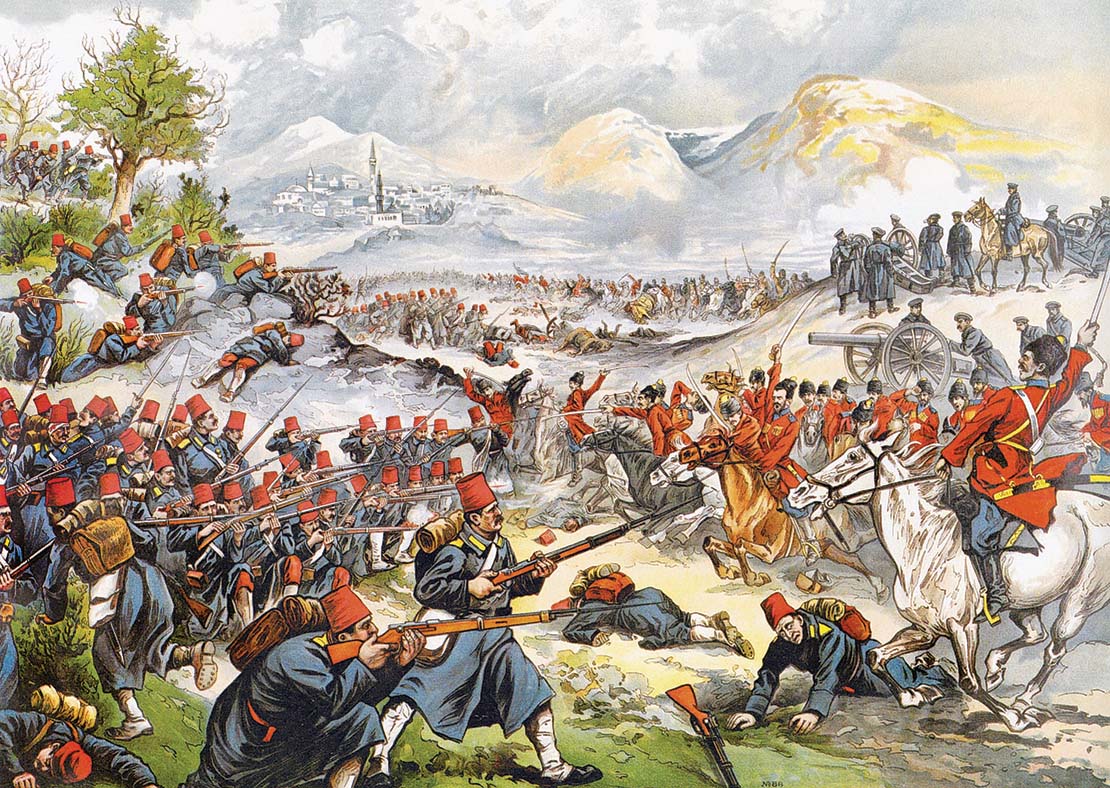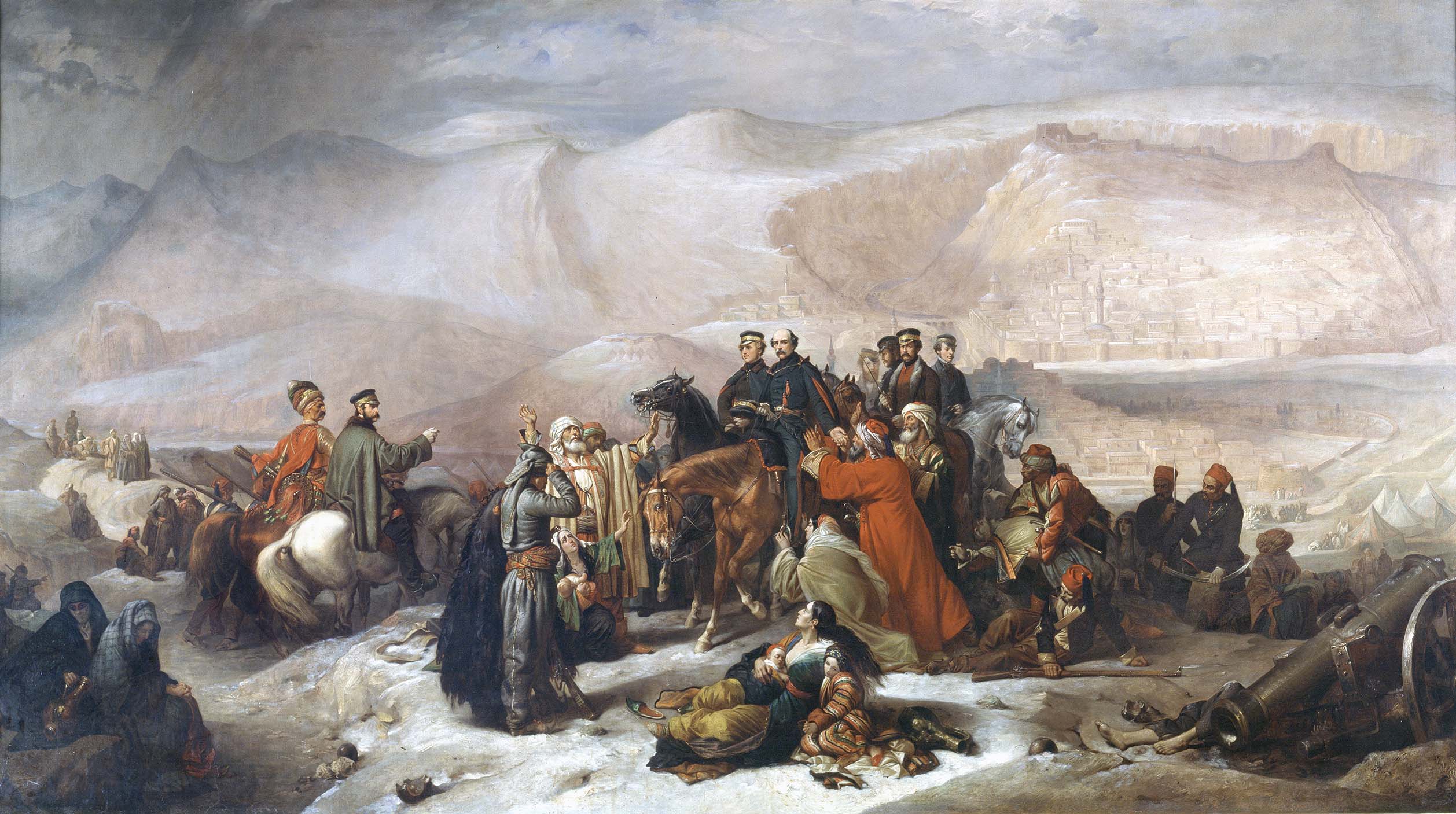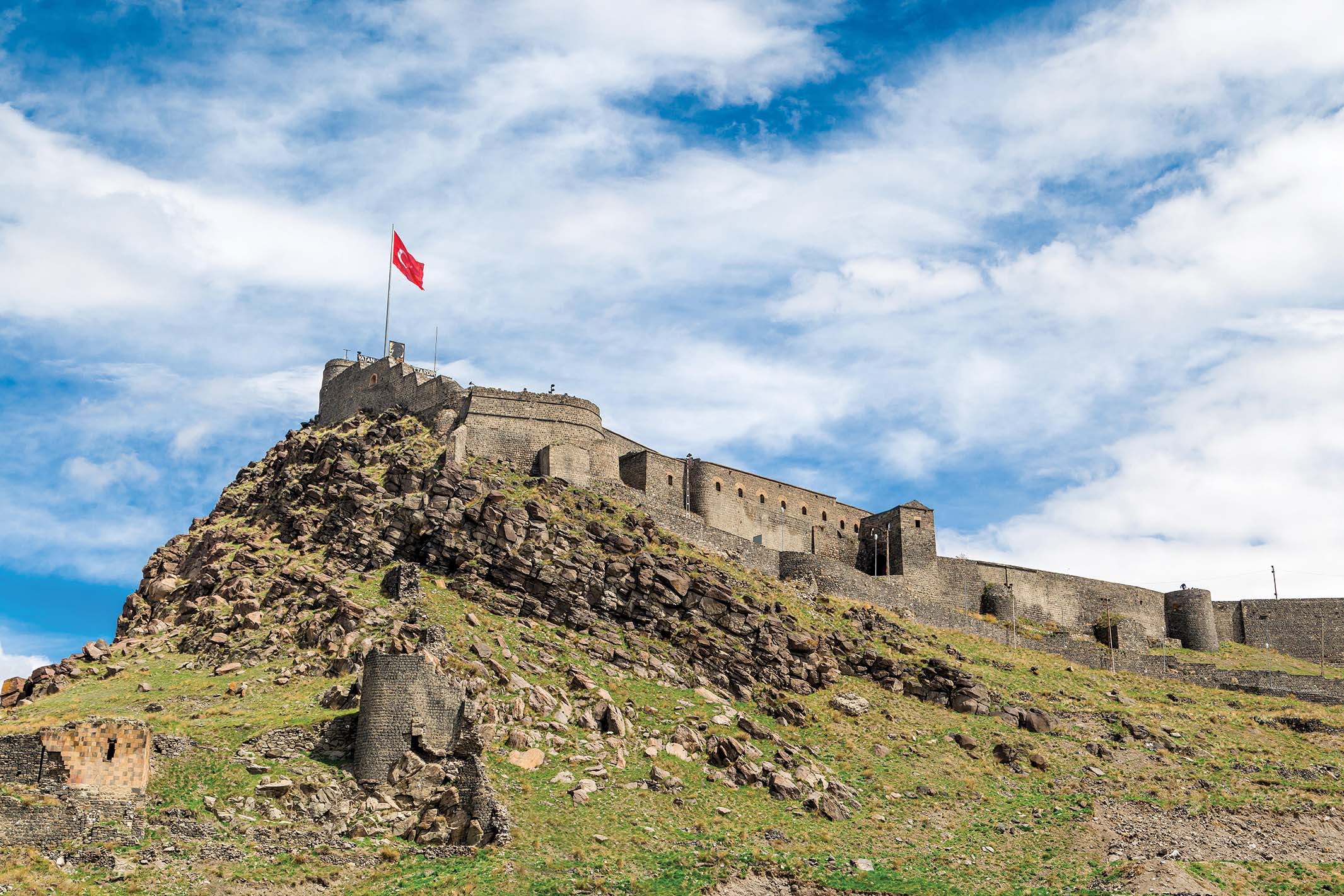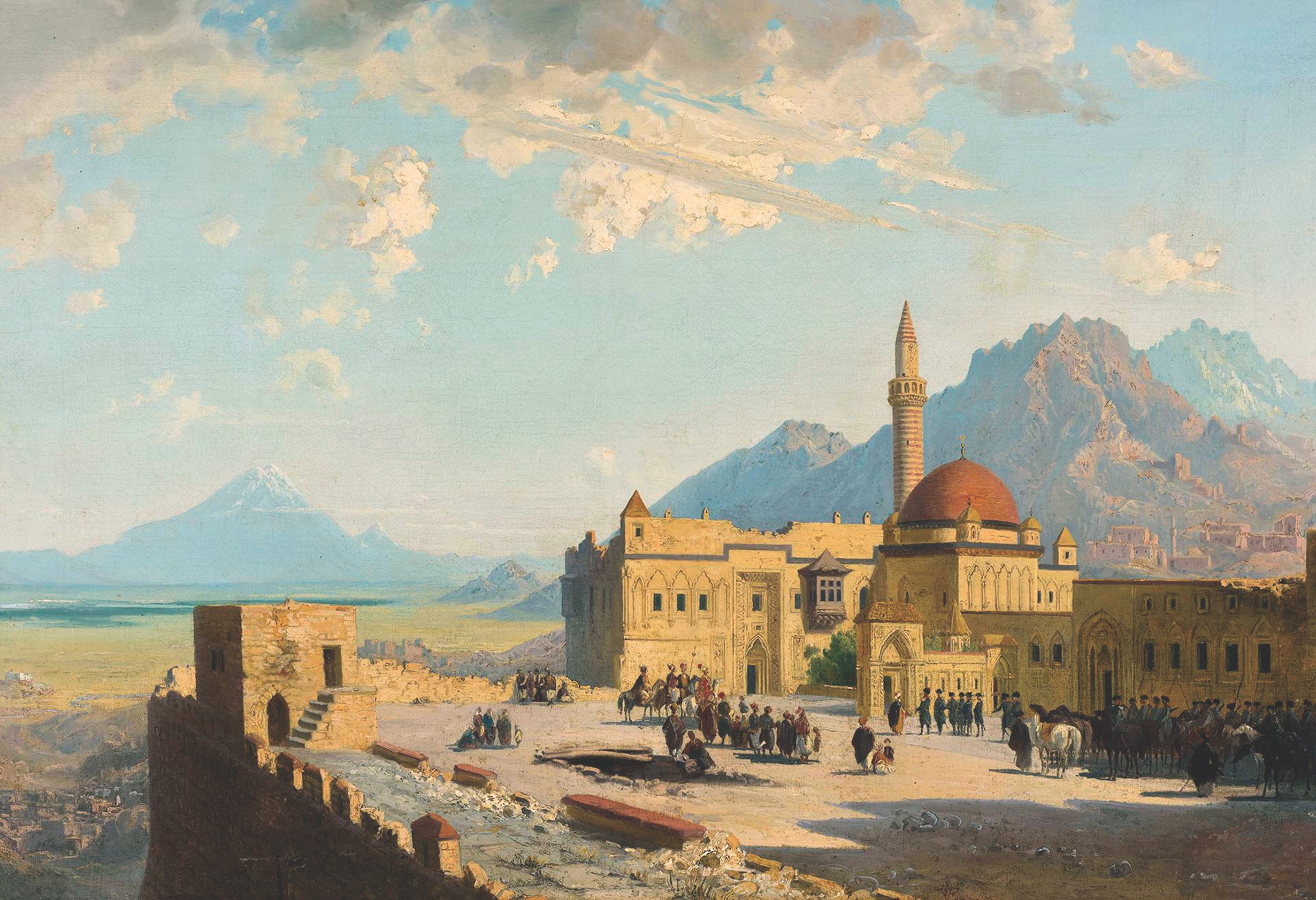For centuries Armenian residents of the Transcaucasian stronghold of Kars watched invaders come and go—until its final betrayal
The very mention of the world’s great fortresses often inspires admiration—Masada, the Alamo, Gibraltar. Such names recall battles synonymous with heroic resistance and national pride. The history of Kars, however, is one of continual strife, humiliating treaties and the final betrayal and embarrassment of a proud people.
The origin of the name Kars is itself a matter of continuing dispute—is it Kars, Qers or Qars? Is it of Armenian, Georgian or Turkish origin? The fortress lies just west of the Turkish-Armenian border on the Akhuryan (or Arpachay) River, between the Black and Caspian seas and south of the Caucasus Mountains. The great historical empires of Persia, Ottoman Turkey and Russia intersected in the region. Also claiming ground here at various times were the Armenians, Byzantines and Mongols.
Coalescing around this hub of empires in the 4th century BC was the Kingdom of Armenia, which in ad 301 became the first state in the world to adopt Christianity as its official religion. With the later rise of Islam to the south and east, the kingdom became increasingly isolated and vulnerable.
In the 9th century, with the threat of Muslim invasion ever present, the Armenians built the first fortifications at Kars, on the rocky heights overlooking the regional capital. Byzantine forces seized the stronghold in the mid-11th century, only to relinquish it a few years later to the Seljuk Turks. Kars changed hands several times between the Turks and Georgians until 1387, when feared Mongol conqueror Timur (better known in the West as Tamerlane) wrested the city from its cowed defenders and incorporated it into his empire. Turks retook the city in 1585, declared it neutral and destroyed its fortifications. It remained under Ottoman rule in the 18th century when Sultan Murad III rebuilt the stronghold to block Persian encroachment in the region, touching off the 1730–35 Ottoman-Persian War.
Although not as comprehensive as the earlier military outworks of James of St. George or Sébastian Le Prestre de Vauban in Western Europe, the Ottoman fortifications were imposing. An abundance of existing basalt enabled the construction of a massive structure whose walls were as solid as concrete.
Perched atop a sheer height hundreds of feet above the adjacent valley, Kars citadel was built on a concentric plan with two ringwalls, the lower one backed by an inner wall 36 feet high and nine feet thick. The walls stretched for nearly 2 miles around the rocky summit, punctuated at intervals by 220 circular and square towers. These bastions allowed defenders to pour enfilading fire on any attackers managing to scale the heights. Unlike Western European castles, the parapets of Kars were not crenelated, and no moat was necessary.
Kars’ principal defensive feature was its lofty vantage. A single narrow road ascended to its gates. Attackers would either have to advance up that narrow defile or scale the heights before charging the walls. A secondary kill zone lay between the walls, designed to isolate any attackers who succeeded in breaching the outer defenses. In the age of ballistae and catapults, Kars was virtually impregnable. While the garrison was heavily fortified, however, the town below remained virtually defenseless.
In late 1734 Nader Shah Afshar—the last notable Asiatic conqueror, known as the “Sword of Persia”—took the Ottoman-Persian War into Transcaucasia when he claimed the region and led an 80,000-man army against a 140,000-man Ottoman force. The Persian army had field artillery but no heavy siege guns, a distinct disadvantage when it came to reducing fortified strongpoints like Kars.
Nader hoped to draw the Turks out of Kars by threatening neighboring cities. When Abdullah Pasha Koprulu did finally march out to meet him, Nader split his army, leading an advance guard of 15,000 men forward while the balance of his force followed within striking distance. On June 19, 1735, the armies clashed near Yeghevard. Despite being outnumbered more than 5-to-1, Nader quickly captured the Turkish artillery and routed the enemy troops, who fled with Persian cavalry close on their heels. Leaving upward of 50,000 dead and wounded comrades on the field, the survivors took refuge within the walls of Kars. A shrewd Nader then gathered the Turkish wounded and sent them back to the city along with the beheaded remains of their commanders, including Koprulu. That strategic one-two punch served to overwhelm the city’s medical facilities and demoralize its garrison.
Flush with his victory in the field, Nader shifted his full attention to Kars. However, his troops not only lacked siege artillery, but also were novices at siege warfare. So instead he had them blockade the city and cut off the garrison’s water supply. Thus avoiding a long, potentially costly siege, the Persian commander subsequently used Kars as a bargaining chip in negotiations with Constantinople. In the final settlement he allowed the Turks to keep the fortress in exchange for the Armenian city of Yerevan. Kars was thus saved from destruction and thereafter marked the border between Ottoman Turkey and Persia.
In 1744 Kars was the locus of a rebellion against Nader’s rule led by Safi Mirza, a pretender to the Ottoman throne. Nader raised another army and marched on the city, reaching it on July 23. This time he brought along a siege train and encircled the city with forts and trenches. Again, however, he eschewed costly direct assaults in favor of cutting off the garrison’s water supply. But the Turks had learned from experience and managed to keep water flowing. On October 9 Nader broke off the siege due to a sudden illness. After recuperating, he returned in June 1745 and encamped near Yerevan.
That summer a 140,000-strong Ottoman army led by Grand Vizier Yegen Mohammad Pasha marched out from Kars to engage the Persians, who were encamped some 10 miles away on the battlefield where they’d fought a decade before. On August 9 the armies met and fought a daylong battle. Nader routed the Turks, and the next day his troops encircled the enemy, blocking their escape route to the castle. Pinned in place for more than a week, the panicked Ottoman soldiers ultimately mutinied and killed Yegen Pasha before fleeing in disarray back to Kars, leaving some 28,000 dead and wounded on the field, compared to 8,000 Persian casualties. As he had done a decade earlier, Nader sent the Ottoman wounded into the city, overwhelming caregivers and damaging morale. He then extended an olive branch, vowing to spare the inhabitants if they surrendered. As all of Anatolia was threatened, Sultan Mahmud I wisely capitulated. Kars had again dodged a bullet, and the Persians went home. Two years later Nader was assassinated by his own officers, and Persia never again threatened the Ottoman empire.
By the 19th century the widespread use of gunpowder weapons had significantly eroded Kars’ defensive value. Not entirely, though, for even if attackers were to bomb the citadel into rubble, they would still have to storm the heights to take the fortress. Given the strength of its walls and daunting elevation, Kars remained a key stronghold in the border region. Though Ottoman military leaders recognized its strategic importance, their defensive forces were stretched thin—from the Caspian Sea to the Mediterranean, and from Egypt to the Persian Gulf. The Turks constructed new works below the citadel, while largely assuming its natural defenses would deter aggressors. A series of 19th century wars with Russia would expose the folly of that assumption.

In 1807 the Turks repulsed one Russian army, but the latter returned in 1828, this time led by Ukrainian-born Lt. Gen. Ivan Paskevich, an experienced and adept field commander. After a three-day battle, during which the Russians pummeled the fortress walls with artillery, the attackers captured Kars and its 11,000-man garrison. The occupation proved short-lived, however, for Russia returned the citadel to Turkey a year later amid peace negotiations.
In 1854, at the outset of the Crimean War, the Russians again knocked at the door. With an imperial army gathering in Georgia, Turkey’s European allies became alarmed Transcaucasia might fall into Russian hands, putting Istanbul and the Black Sea straits at risk. Even discounting that threat, the fall of Kars would imperil the Allied siege of the Russian fortress of Sevastopol. As the timid provincial governor, Zarif Mustafa Pasha, seemed neither willing to emerge and give battle nor capable of holding the capital against a determined attack, it seemed only a matter of time before Kars fell.
In August 1854 Field Marshal FitzRoy Somerset, Lord Raglan, commander of all Allied forces in Crimea, dispatched Maj. Gen. Fenwick Williams and an “advisory team” to stiffen Kars’ defenses. (In the Victorian era the British would notoriously repeat the pattern, sending inadequate forces to near hopeless situations in distant corners of the empire—notably Lord Chelmsford in Zululand in 1879 and Maj. Gen. Charles Gordon at Khartoum in 1884.) Williams arrived at Kars in late September 1854 to find a demoralized conscript garrison of 17,000 Turks armed with obsolete weapons and manning crumbling defenses. Pushing aside Mustafa Pasha, Williams took command and virtually single-handedly worked a military miracle over the next six months, reinforcing the fortifications and whipping the Turkish garrison into fighting shape. In the process he discovered his Turkish troops were not bad soldiers—just badly led.
Rather than cower within the citadel walls, Williams extended the defensive works until the city itself was ringed with eight forts and redoubts interconnected by trench lines that provided interlocking fields of fire. Thanks to his efforts, for the first time in its history Kars comprised a truly fortified city, as opposed to a lone citadel overlooking a city.
The anticipated Russian attack came in June 1855 with some 25,000 troops and 96 guns led by Gen. Nicolay Muravyov, who probed the defenses before mounting a siege. Muravyov had no heavy siege guns, and his supply line back to Georgia was vulnerable, but that didn’t matter. His primary objective was to relieve Allied pressure on Sevastopol. Over the next three months Russian troops overran the fortress’ outer defenses and established a foothold on the heights, but they were unable to push into the city itself. Kars’ British-trained Turks fought with a ferocity that surprised the attackers.
The siege continued into fall, by which time the defenders suffered from cholera and were dangerously short of supplies. Williams cut rations repeatedly and sent dispatches begging for help, but the British high command turned a deaf ear to his entreaties. Finally, on September 6 the Ottoman commander in Crimea, Omar Pasha, pulled 45,000 troops from the line at Sevastopol to go to Kars’ relief. Had he done so any earlier, it might have proved a devastating blow to the siege of the former, but Sevastopol fell to the Allies three days later.
Omar Pasha landed on the Black Sea coast north of Kars in late September, about the time Muravyov launched an all-out assault on the city. The starving defenders managed to repulse the seven-hour assault while inflicting nearly 7,000 casualties on the attackers. But Omar Pasha dallied, spending his army’s strength on attacks against secondary targets that failed to tilt the strategic balance.
By late October the garrison at Kars was beyond desperate. The first snow had fallen, and supplies were nearly exhausted. The Ottomans landed yet another army on the Black Sea coast, this one under Omar Pasha’s son Selim Pasha, but he too marched away from Kars, in an effort to save western Anatolia. By then Muravyov was so confident of success that he detached a small force to deal with Selim Pasha, stopping the latter’s advance on November 6.
Finally, on November 28, having abandoned all hope of relief, Williams surrendered his surviving British and Turkish officers and men to the Russians. On entering Kars, the victors were horrified at the conditions they found. Unburied victims of starvation and disease lay stacked in the streets, the survivors simply too weak to bury them.

Many others died over the coming days. In the final weeks of the siege only Williams’ iron will and the city’s mighty fortifications had held the enemy at bay. The British general’s after-action report praised his men: “They fell dead at their posts, in their tents and throughout the camp as brave men should who cling to their duty through the slightest glimmering of hope of saving a place entrusted to their custody.”
Following the siege the combatant nations honored their respective heroes. In recognition of Williams’ remarkable stand, Queen Victoria created him 1st Baronet of Kars. On the winning side Emperor Alexander II was so pleased with the results that he pinned medals on the deserving Muravyov, as well as the emperor’s own brother Grand Duke Michael, the regional governor general, whom Allied officers derided as “frightened as a rabbit on the battlefield.” Alexander also authorized Muravyov to change his surname to Muravyov-Karsky, allowing his family to forever tout his triumph. While the capture of Kars hardly made up for the loss of Sevastopol, it served to assuage Russian pride.
More important, Kars again became a diplomatic bargaining chip in peace negotiations, the Russians returning it to the Ottomans in the 1856 Treaty of Paris. That is, until the next round of fighting, which came amid the 1877–78 Russo-Turkish War. In November 1877 Russian forces under Gens. Mikhail Loris-Melikov and Ivan Lazarev again captured the fortress from the hapless Turks. This time, however, in the 1878 Treaty of San Stefano, they kept it along with other chunks of Ottoman territory.
Under Russian sovereignty the city became the provincial capital of the Kars Oblast (province), marking the southwestern edge of Romanov territory. When the Russians imposed Eastern Orthodox Christianity on the region, thousands of Muslims fled across the border into Turkey, including 11,000 from Kars alone. In a reverse migration, Christian Armenians and Greeks streamed into Kars from Ottoman territory, setting the stage for the next great struggle.
In November 1914 Ottoman Turkey entered World War I on the side of Austria-Hungary and Germany, largely to reclaim territory lost to Russia, including Kars. Within weeks an Ottoman army invaded Transcaucasia. Though it lost at the Battle of Sarikamish in January 1915, it nevertheless regained Kars in the 1918 Treaty of Brest-Litovsk. Once again the Turkish flag flew over the embattled city and its restive, largely Armenian population. Ottoman troops occupied the city on April 25, 1918, but at war’s end the Allies ordered Turkey to return to its prewar borders, an arrangement formalized in the 1920 Treaty of Sèvres.
Unwilling to cede territory to the Soviet Union, the Allies recognized Armenia in the treaty as an independent republic. Tasked with ensuring the peaceful transfer of Kars from Turkish to Armenian control, British Col. Alfred Rawlinson deemed it an impossible assignment that “could only have been carried into effect by the permanent occupation of the [region]…by considerable forces of European troops”—something that was never going to happen. The United States refused to accept a proffered League of Nations mandate over Armenia to keep the peace, setting the stage for yet another round of warfare.
The transfer of Kars was anything but peaceful. Armenian troops roamed the countryside committing atrocities against Turks, while the city’s Ottoman military governor refused to accept the treaty terms, proclaiming a provisional Turkish government over the region. The Ottomans weren’t strong enough to back the claim and were ousted in April 1919 by a joint British-Armenian force. The troops entered Kars and arrested all Turkish officials who had not fled, sending them into captivity on Malta. A month later Armenia named Kars capital of its Vanand province. Once again it was a besieged city, not in the classic sense, but as the target of an insurgency against Armenian rule with the backing of the new Turkish nationalist government under Mustafa Kemal Atatürk.
Turkey launched a full-scale invasion of Armenia in September 1920. Four divisions under Brig. Gen. Kâzim Karabekir crossed the border and bore down on Kars. Having expected the assault, the Armenians had upgraded the city’s defenses, starting with the ancient citadel on the heights. They optimistically pronounced it “impregnable,” figuring Kars could withstand any siege long enough for an Armenian relief force to arrive. It was not to be.

On October 30 the commanding officer at Kars threw open the city gates and allowed the Turks to walk in. The Turks in turn marched thousands of bewildered officers and enlisted men out into captivity. Though doubtless glad to be alive, the Armenians bore the shameful knowledge they had not fired a single shot. It was an unprecedented act of treason as well as a military fiasco, although it went little noticed in the West, in which Gibraltar and Verdun were historical measuring sticks for “holding the fort.”
One top Armenian army general committed suicide rather than face the shame. “Kars fell, but it was not defeated,” the city’s civil governor said. “It became the victim of our criminal negligence.” In the subsequent humiliating 1920 Treaty of Alexandropol, Armenia gave back Kars and all the other Turkish territory it had received in the Treaty of Sèvres.
The city made one more notable appearance on the stage of history. Soviet forces occupied Armenia in 1921, imposing a treaty on Turkey that established the border between Turkey and the Soviet Union’s three Transcaucasian republics. Signed in Kars on October 13, the treaty left the fortress in Turkish hands—one of few concessions the Soviets made to a weakened Turkey. A century later the Treaty of Kars remains an object of Armenian scorn.
Though the present-day historic fortress is a popular tourist attraction among foreign visitors, its dark history remains largely unknown in the Western world and is celebrated neither by the Turks nor by the Armenians. Like the city’s former Armenian Holy Apostles Church—which was converted into a mosque in 1993—Kars fortress stands as a monument to a turbulent past. MH
Richard Selcer is a Texas-based author and professor of history. He has published 13 books and taught for more than 40 years. For further reading he highly recommends The History of Armenia: From the Origins to the Present, by Simon Payaslian, and The Sword of Armenia: Nader Shah, From Tribal Warrior to Conquering Tyrant, by Michael Axworthy.
This article appeared in the December 2021 issue of Military History magazine. For more stories, subscribe and visit us on Facebook.





